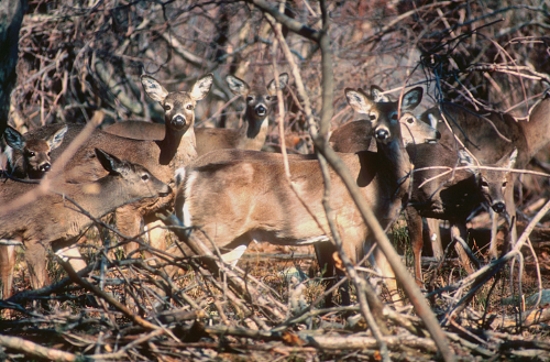Press Releases

10/10/2017
Motorists, Watch for Deer and Moose this Fall
Connecticut’s Department of Energy and Environmental Protection (DEEP) reminds motorists to be watchful of increased deer and moose activity along roadways, especially during early morning and evening hours. Fall is the peak of the breeding season for Connecticut's small but expanding moose population in the northern part of the state. The breeding season (also known as "the rut") for white-tailed deer closely follows the moose breeding season, running from late October through late December.
DEEP’s Wildlife Division says motorists should be aware and heed “Deer Crossing” signs along state highways. Motorists are advised to slow down and drive defensively should a deer or moose be spotted on or by the road. Because moose are darker in color and stand much higher than deer, observing reflective eye-shine from headlights is infrequent and, when struck, moose often end up impacting the windshield of vehicles. All moose and deer vehicle collisions should be reported to local, state, or DEEP Environmental Conservation Police Officers (860-424-3333).
“During 2016, approximately 3,700 deer were killed in the state due to collisions with vehicles,” said Rick Jacobson, Director of the DEEP Wildlife Division.
“Over 40 moose-vehicle accidents have been reported in Connecticut between 1995 and 2016, with an average of two per year since 2002,” continued Jacobson. “Two moose-vehicle accidents have already occurred this past September. It is believed that one of the moose traveled from Stafford to Essex over a five-day period before being struck by a motorist.”
Most of Connecticut is not considered ideal habitat for moose because the state’s landscape is fragmented, roadways have high traffic volume, and moose have large home ranges (approximately 10-15 square miles). Moose venturing into southern Connecticut, with high population density, road networks, and traffic volumes, pose an increased potential for human fatalities from accidents as compared to deer-vehicle accidents. Residents throughout the state are encouraged to report moose sightings on the DEEP website at www.ct.gov/deep/wildlife.
Attachment – Photo of a white-tailed deer herd – Photo Credit: Paul J. Fusco / CT DEEP-Wildlife

Suggested Caption: Connecticut’s Department of Energy and Environmental Protection Wildlife Division reminds motorists to be watchful of increased deer and moose activity along roadways, especially during early morning and evening hours.
- Twitter: @CTDEEPNews
- Facebook: DEEP on Facebook

